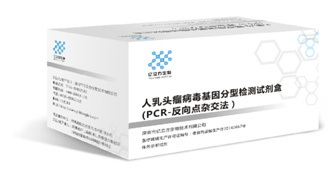Clinical background

Cervical cancer is the fourth most malignant tumor in women. According to data published by the National Cancer Center, in 2015, there were about 98,900 new cases of cervical cancer and about 30,500 deaths in China, which are seriously threatening the health and life of women in China. At present, studies have confirmed that persistent infection of high-risk human papillomavirus (HPV) is a necessary condition for cervical cancer to develop. 28 HPV genotypes: including HPV high-risk types: 16, 18, 31, 33, 35, 39, 45, 51, 52, 56, 58, 59, 68; HPV suspected high-risk types: 26, 53, 66, 73, 82; HPV low-risk type: 6, 11, 40, 42, 43, 44, 54, 61, 81, 83
Significance of genetic testing
1. It is suitable for genetic diagnosis of clinical HPV infection, assisting the screening of condyloma acuminatum and cervical cancer, and monitoring its treatment effect, etc., which can provide a scientific basis for the diagnosis of patients with HPV-related diseases;
2. Cervical cancer is the only clear cause and can be early Cancer detection and prevention, early elimination. The International Cancer Society believes that persistent infection of high-risk HPV viruses is the main cause of cervical cancer. The detection of HPV typing can be used to determine the risk of cervical cancer and achieve individualized tumor prevention and treatment;
3. Different types of HPV infection cause cervical cancer Risks are different, and typing test can provide guidance for risk assessment and epidemiological investigation;
4. Guide the shunt treatment of cervical cytology test results ASCUS and LSIL, exclude suspicious lesions and low-grade lesions, improve diagnosis credibility and reduce missed diagnosis Risk;
5. Can be used for follow-up treatment of cervical cancer lesions.
Product advantages
1. High-throughput, sensitive, specific and fast, can simultaneously detect 28 kinds of HPV genotypes
2. Fast detection, stable experimental method, low cost, and the required equipment price is not high
3.28 kinds of HPV genotypes : Includes HPV high-risk types: 16, 18, 31, 33, 35, 39, 45, 51, 52, 56, 58, 59, 68; HPV suspected high-risk types: 26, 53, 66, 73, 82; HPV low-risk Type: 6,11,40,42,43,44,54,61,81,83
4. Specificity above 98%, no cross reaction between types
5. Accuracy above 98%
6. Repeatability above 98%
7. High sensitivity, detect the minimum copy number of HPV-DNA 104copies / mL
Application field
1. By detecting whether there is a high-risk HPV infection, combined with cervical cytology screening for cervical cancer, to better determine the risk of cervical lesions
2. For atypical squamous cells and gland cells (AS-CUS / AGUS) and cervical Shunting and management of people with low-grade intraepithelial lesions (LSIL)
3. Tracking and follow-up after treatment of cervical lesions 4.
Important basis for HPV epidemiological investigation and vaccine development
Product information
Test specimens : Cervical exfoliated cell samples, genitourinary tract secretions
Technical principle : PCR-reverse dot hybridization
Packaging specifications : 25 tests / kit
Class : In vitro diagnostic reagents
Applicable instruments : Gene amplification instrument, molecular hybridization instrument



